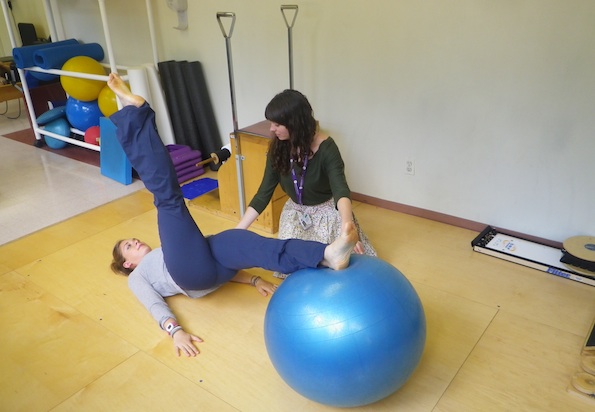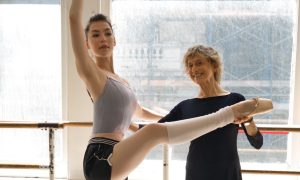By Leigh Schanfein of Dance Informa.
Who is an athletic trainer?
The National Athletic Trainers Association (NATA) defines Athletic Trainers (AT) as “health care professionals who collaborate with physicians to provide preventative services, emergency care, clinical diagnosis, therapeutic intervention and rehabilitation of injuries and medical conditions.” They specialize in educating and treating patients in order to prevent injury and re-injury. As the name suggests, they primarily work with athletic populations but they may work with other patient groups under the umbrella of physical medicine and rehabilitation.
Considering all they do, I’m surprised I didn’t find out about Athletic Trainers until I was in college, which is when I discovered them through the assets of the university sports teams. Fortunately, I was able to access care because of my proximity to some massive sports funding, though I was left wishing I’d known about what ATs could do for dancers earlier in my training. A lot of dancers don’t realize they have access to the great expertise of ATs, particularly those at university.
The dancers at SUNY Purchase, however, know all about the amazing care dancers can get from a Certified Athletic Trainer (ATC). They have regular access to Lauren Kreha, ATC, Clinical Specialist at the Harkness Center for Dance Injuries, NYU Langone Medical Center in New York. Lauren provides clinical care as well as a great deal of preventative care for dancers in companies like Cedar Lake Contemporary Ballet and Ballet Hispanico, as well as at Purchase. She wants dancers to see her before they are injured so that they can avoid dance injuries.
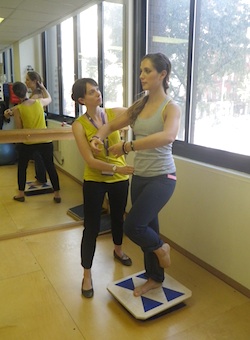
Lauren Kreha working with a dancer at the Harkness Center for Dance Injuries. Photo courtesy of Lauren Kreha.
“You don’t need to be hurt to see me. A lot of the time, dancers in my athletic training room just come for nutrition advice, to vent, or work on getting stronger. Athletic trainers have the opportunity to build rapport with dancers before they’re hurt, which makes it easier to comfort and treat them in those moments of crisis.” ATs like Lauren put in the extra work to make sure dancers like you don’t get injured, get well as quickly as possible, and return stronger so they don’t get injured again.
Can I trust them with my dance injuries?
Just as you would trust a doctor, physical therapist, masseuse or acupuncturist, an AT is a licensed health care provider, and whether or not you should trust them with your injury depends on what kind of experience they have with dancers and our somewhat unique needs. Fortunately, ATs are used to working with athletes who have extremely similar demands to those of dancers. Just as they know an athlete needs to get back onto the field or court, they will understand your need to get back into the studio or on stage as quickly and painlessly as possible.
As Lauren points out, an AT’s training makes him or her ideal for working with dancers. “We understand the need for a dancer to return to peak physical condition as quickly as possible, and are highly skilled in finding ways to make that happen,” she said.
Also critical for dancers is getting help right away so an injury doesn’t get worse because care wasn’t available or the dancer was afraid to go to someone about his or her injury. Sometimes, this means getting help immediately in the wake of a serious injury that can threaten the overall health, livelihood, and even the life of the dancer. “Athletic trainers are also prepared to evaluate injuries right after they happen and make quick decisions about returning to activity or referral. One of the things that makes me most proud to be an athletic trainer is that you can not only trust me with dance injuries (e.g. ankle sprain) but also life-threatening injuries. I am ready to respond if your heart stops beating, and can save your life.”
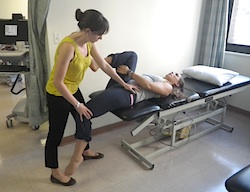
Lauren Kreha stretching a dancer at the Harkness Center for Dance Injuries. Photo courtesy of Lauren Kreha.
How does an athletic trainer differ from a physical therapist or a personal trainer?
Though they have a similar name, ATs and personal trainers have very different roles. ATs go to school for a bachelor’s and/or master’s degree in athletic training, and 46 states also require them to become certified (that’s the “C” in ATC). They work under the direction of a physician to prevent, diagnose and intervene in emergency, acute and chronic medical conditions. They are healthcare professionals. A personal trainer develops and implements exercise programs according to fitness goals and is not qualified to provide medical care.
Physical therapists and ATs have more in common when it comes to schooling, level of expertise, and what exactly they are permitted and expected to do with a patient.
After beginning an education that started out with a combined Athletic Training/Physical Therapy track, and learning the skills that both professions attain, Lauren realized she wanted specifically to pursue the AT because of the critical care component. “Athletic trainers (in the traditional sense) are there when an injury occurs. There’s a lot of excitement in immediate care and acute assessment that you don’t get in the clinic.”
How do I find a trustworthy ATC in my town?
Because ATs must practice under the direction of a physician, they will be associated with medical teams at clinics, hospitals, high school and university settings, and other medical organizations. Lauren makes a particularly important point about getting in to see an expert at your school or medical center: “If you don’t currently have access to their care, change that! One of my interns last summer was a dancer at my athletic training alma mater. We talked about getting the dancers access to the athletic trainers on campus, and then [she] went back to GVSU and made it happen!”
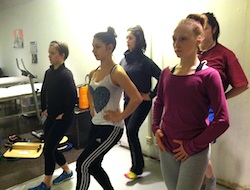
ATC Lauren Kreha working with a group of her SUNY Purchase students in a “Running for Dancers” workshop. Photo courtesy of Lauren Kreha.
Sometimes it’s not obvious how to find an AT, but if there are athletics in your town, there is probably at least one AT associated with that team, and you can seek them out or inquire if there is a branch of their services that non-team athletes can access. Never be afraid to ask, you might just find your new best friend in injury prevention and rehabilitation!
Lauren Kreha, ATC, is a Clinical Specialist at the Harkness Center for Dance Injuries at NYU Langone Medical Center. She provides backstage coverage for Broadway shows and dance companies in New York City as well as injury prevention assessments and educational lectures to the dance community.
Photo (top): ATC Lauren Kreha working with a dancer at the Harkness Center for Dance Injuries. Photo courtesy of Lauren Kreha.


